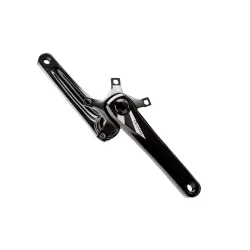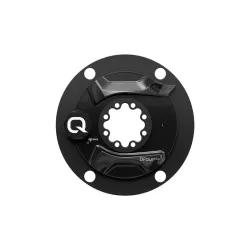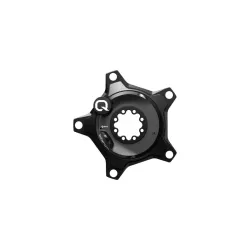Rotor INPower 3D+ Crank
- Stock: In Stock
- Model: SG7464
- MPN: 01102138
Available Options
Rotor INPower 3D+ Crank
The Rotor 3D+ crank is the zenith of Rotor’s road lineup. Here, Rotor has added their INpower spindle to provide you with one of the lightest (only 525g), stiffest power meter cranks on the market. It’s the perfect crank for your Rotor Q- and QXL-rings when you desire to take measure of your power.
INpower refers to the system Rotor utilizes for measuring power. They’ve put the strain gauges and the hardware inside their Universal Bottom Bracket (UBB) thru-axle. Inside the bb=INpower. A 30mm hollow aluminum axle isn’t only strong and light: it’s got room for electronics. There are two strain gauges embedded inside the spindle. They’re powered by a single AA battery, which lasts for up to 300 hours of riding. The signal is sent via the ANT+ protocol from a transmitter on top of the left crankarm to any ANT+ enabled head unit. Stashing the electronics inside the axle does several good things. It is protected from the elements. It is protected from crashes. It puts the added weight, which is about 30g here, inside the smallest possible circle: the added mass is rotating in the smallest circle possible. It is about as waterproof as a powermeter can get. And it makes the unit less temperature-sensitive: in fact, along with the programming, temperature should not affect INpower at all.
Accuracy of the INpower power meter is +/- 1.7% with Q-rings, and +/- 2.8% with QXL chainrings. This is much better than other crank-based power meters. Rotor’s hardware inside the crank takes 200 power samples per second while it is on, computes and averages those numbers five times per second, and those five samples are sent to your head unit.
INpower might seem like a standard power meter measuring power off the left crankarm. It does that, but it also does much more. Rotor provides two unique metrics that, when studied, can help you improve your pedal stroke. The first is Torque 360, which measures the distribution of pedaling forces throughout the pedal stroke. The second is OCA, Optimum Chainring Angle, which can tell people utilizing Rotor Q-Rings where they should orient the Q-rings relative to the crank. These can be found by installing Rotor’s software to your Mac (OSX 10.7 or later) or Windows (Windows Server 2003, 2008, XP SP3, Vista, 7, and 8) computer. With the software and an ANT+ dongle inserted in a USB port, you can watch and record indoor training sessions on your computer in real time to better analyze your pedaling. And you can specify from five to 50 samples per second to really drill down into your stroke. This is also how you can diagnose crank issues and update firmware. Even if you aren’t planning on watching your pedal stroke on a regular basis, install the software, not only can you update the power meter’s firmware, but the software doubles as a training log.
Rotor’s 3D+ Crankset gives you Rotor’s lightest, stiffest arms. The arms are machined as per Rotor’s Trinity Drilling System. Three holes are machined lengthwise down the arms. The spider has five arms, and possesses a 110mm or 130mm bolt circle diameter.
And, of course, there’s Rotor’s UBB spindle. The 30mm spindle is designed to work with nearly every standard you can find on the market. English (BSA) or Italian (ITA) threaded, BB30, PF30, BBright, BB386EVO, BB86, all work, provided you install the proper Rotor bottom bracket.
The Rotor INpower 3D+ Crankset comes with a user manual, a software manual, a TrainingPeaks manual on training with power, a free trial of TrainingPeaks, and a free month of a TrainingPeaks training plan.















